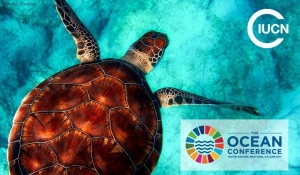IUCN Statement at The Ocean Conference Plenary
Location: New York, USA. 16th Jun 2017
Excellencies, Distinguished Participants,
It is my honor to deliver this statement on behalf of the International Union for Conservation of Nature – IUCN -- at this historic UN Ocean Conference.
IUCN applauds the dedication of so many in this room, and outside, to halting and reversing the decline of our ocean. IUCN welcomes the Call for Action to deliver on the promise of SDG-14 that is to be adopted by this Conference. IUCN is especially heartened by the reference to the UNFCCC Paris Agreement and sees its implementation as vital for ensuring our ocean can continue to provide the goods and services on which we so heavily depend. However, as a global statement of political will, the Call to Action is only as good as our resolve, once we leave this room, to put it into practice in our day-to-day work. To maintain this momentum, IUCN is committed -- through our members, our broad network of scientists, governments and NGOs, our Commissions and Secretariat – to do our part in partnership with others.
For decades IUCN has worked at multiple levels – with international and regional organizations, national and local governments, and communities and civil society organizations – to safeguard and foster conservation, sustainable management and use of marine and coastal ecosystems and biodiversity. We forge partnerships 2 as a main vehicle for delivering concrete results on the ground, or rather in the water. We are very pleased to see that building and strengthening partnerships is one of the main elements of this Conference. We are contributing to that outcome by deepening our collaboration with partners on many fronts. Specifically, we have committed to scaling up our ambition through such global, cross-sectorial partnerships as Mangroves For the Future, Blue Action Fund, the International Blue Carbon Partnership, Biodiversity and Ecosystem Services in Territories of European overseas (BEST), Friends of Ecosystem based Adaptation (EbA), to name a few. Further, of course, as the holder of the world’s Barometer of Life, IUCN issues the IUCN Red List which documents the perilous path of the state of the world’s marine life.
But time is not on our side. The ocean is being stretched beyond its carrying capacity.
IUCN would like to stress six priority areas in which we, as global ocean stewards, need to accelerate action if we are to achieve SDG 14 and related goals.
- First. We need to move swiftly to lower global greenhouse gas emissions which continue to worsen the problem of ocean acidification, ocean warming and de-oxygenation, leading to sea-level rise, with adverse impacts on corals, shellfish and other marine life, and shifts in the ranges of marine species.
- Second. We need to accelerate progress in extending and managing representative networks of well-connected marine protected areas with full, effective and equitable participation of local communities and respect for the voice and rights of indigenous peoples.
- Third. We need to work tirelessly to end overfishing and support a transition to sustainable fisheries which can continue to feed a growing world population for generations to come, without depleting these precious resources or undermining marine biodiversity or ecosystem health.
- Fourth. We need to end unsustainable practices that undermine the integrity and resilience of marine and coastal ecosystems from the seashore to the deepest trench, and the water column in between.
- Fifth. We need to tackle head-on and urgently the various sources of marine pollution, from agriculture and sewage to plastics and microplastics – especially as their accumulation impacts coastal communities’ and other people’s health and the ecosystems on which we all depend.
- And finally sixth. We need to convene without delay an intergovernmental conference to negotiate an international legally binding instrument under UNCLOS to ensure a global regime for the conservation and sustainable use of marine biodiversity beyond national jurisdiction.
In forging ahead, IUCN sees not merely threats but opportunities, in particular in working with nature to address some of our biggest sustainable development challenges. The ocean and its ecosystems offer multiple ‘nature-based solutions’. The use of the potential of coastal ecosystems such as mangroves and seagrass beds as ‘blue carbon’ to mitigate climate change while at the same time enhancing resilience and adaptation capacity is just one example.
IUCN also recommends that due consideration be given to a robust follow-up process needed to ensure that the momentum reflected in the current registry of voluntary commitments is sustained, including the possibility of establishing a UN Ocean Ombudsman or Special Rapporteur to provide the focus needed for reviewing progress.
In closing, IUCN is looking forward to working with everyone so that the commitments generated around this conference can be swiftly put into action to solve the problems faced by the world’s ocean for the benefit of our children and grandchildren.

IUCN at the Ocean Conference © Pixabay